Just to add a little to the discussion. My No Turn 6BRA won the Tac Driver.
Install the app
How to install the app on iOS
Follow along with the video below to see how to install our site as a web app on your home screen.
Note: This feature may not be available in some browsers.
You are using an out of date browser. It may not display this or other websites correctly.
You should upgrade or use an alternative browser.
You should upgrade or use an alternative browser.
To Turn Necks or Not ?
- Thread starter jamesdmock
- Start date
I’ll provide a different use case than Bart on why I turn (some) cases, though I have no issue with his logic and results on directly testing every case for velocity.
I bought 1000 lapua 223 cases specifically to shoot berger 85.5 for positional shooting practice. Even at 2.520 total length, the 85.5 is seated a bit below the neck/shoulder junction. Seating in brand new brass it’s apparent a doughnut exists before you’ve even fired it
I tried not to worry about it but I was seeing SD/ES numbers that were in the 20/50 range which drove me nuts. Accuracy was also not up to my expectation.
I’ve now had to both turn and weight sort the cases to get the ES down as well as stop throwing fliers in otherwise decent groups.
It definitely wasn’t part of my plan when building this gun, but sometimes you gotta do what you gotta do.
I bought 1000 lapua 223 cases specifically to shoot berger 85.5 for positional shooting practice. Even at 2.520 total length, the 85.5 is seated a bit below the neck/shoulder junction. Seating in brand new brass it’s apparent a doughnut exists before you’ve even fired it
I tried not to worry about it but I was seeing SD/ES numbers that were in the 20/50 range which drove me nuts. Accuracy was also not up to my expectation.
I’ve now had to both turn and weight sort the cases to get the ES down as well as stop throwing fliers in otherwise decent groups.
It definitely wasn’t part of my plan when building this gun, but sometimes you gotta do what you gotta do.
So how much total clearance without the brass being turned in you chamber.I’ll provide a different use case than Bart on why I turn (some) cases, though I have no issue with his logic and results on directly testing every case for velocity.
I bought 1000 lapua 223 cases specifically to shoot berger 85.5 for positional shooting practice. Even at 2.520 total length, the 85.5 is seated a bit below the neck/shoulder junction. Seating in brand new brass it’s apparent a doughnut exists before you’ve even fired it
I tried not to worry about it but I was seeing SD/ES numbers that were in the 20/50 range which drove me nuts. Accuracy was also not up to my expectation.
I’ve now had to both turn and weight sort the cases to get the ES down as well as stop throwing fliers in otherwise decent groups.
It definitely wasn’t part of my plan when building this gun, but sometimes you gotta do what you gotta do.
Ned Ludd
Silver $$ Contributor
I'm curious about this question also. In my hands using .223 Rem Lapua brass with un-turned necks and ~90 gr bullet weights, I have never been able to reproducibly obtain ES values below around 15-20 fps. This is almost double the ES values I can routinely obtain with .308 Win loads using un-turned Lapua brass, and I always assumed that the much smaller case volume was a contributing factor. However, it's worth noting that I have at least .002" clearance per side in my .308 Win chambers. I do know a couple people using .223s in F-TR that had difficulties obtaining ES values below 35-40 fps, that were able to knock the ES back down into the low/mid 20s by turning necks. In my case, the chamber neck dimension is 0.2527", +/- manufacturer tolerance. The neck diameter of a loaded round is very close to 0.250", meaning I only have between 0.0010" and 0.0015" clearance per side. Obviously, neck turning, or even just a "skim pass" would increase the clearance a bit. So I'm wondering whether doing so might bring the ES values that typically range from mid/upper teens to around 25 fps down a bit; i.e. closer to the range I obtain with .308 Win loads, or if that has a more noticeable effect in the .223 Rem only when the ES is much higher to start with, say in the 35-40+ fps range? @dnellans - what kind of ES range did you observe after turning the necks? I am assuming it was lower from your post, but you didn't give the actual ES range after turning the necks.So how much total clearance without the brass being turned in you chamber.
My .268 turned Dashers won the 1k and 600 nats this year. LOLJust to add a little to the discussion. My No Turn 6BRA won the Tac Driver.
I think that it's more about the tuning than the turning. I'm running .003" clearance but by turning I know it IS .003" everywhere. With a no turn I would think that as long you had sufficient clearance at the tightest spot than you should be good to go but that means you are going to have more than desired on the skinny sides. I'm curious to see what guys are running on clearance on the no turns. I'm going to run some Alpha Dasher brass in a .272 neck BUT I'm going to turn them and should end up with a shade over .003 clearance all said and done. I anneal all of my brass after every firing as well.
I'm curious about this question also. In my hands using .223 Rem Lapua brass with un-turned necks and ~90 gr bullet weights, I have never been able to reproducibly obtain ES values below around 15-20 fps. This is almost double the ES values I can routinely obtain with .308 Win loads using un-turned Lapua brass, and I always assumed that the much smaller case volume was a contributing factor. However, it's worth noting that I have at least .002" clearance per side in my .308 Win chambers. I do know a couple people using .223s in F-TR that had difficulties obtaining ES values below 35-40 fps, that were able to knock the ES back down into the low/mid 20s by turning necks. In my case, the chamber neck dimension is 0.2527", +/- manufacturer tolerance. The neck diameter of a loaded round is very close to 0.250", meaning I only have between 0.0010" and 0.0015" clearance per side. Obviously, neck turning, or even just a "skim pass" would increase the clearance a bit. So I'm wondering whether doing so might bring the ES values that typically range from mid/upper teens to around 25 fps down a bit; i.e. closer to the range I obtain with .308 Win loads, or if that has a more noticeable effect in the .223 Rem only when the ES is much higher to start with, say in the 35-40+ fps range? @dnellans - what kind of ES range did you observe after turning the necks? I am assuming it was lower from your post, but you didn't give the actual ES range after turning the necks.
Hi Ned & Bart - long pust but here is that gun's specifics and follow up. I went out and took some measurements with the mic so that I'm not mis-remembering any data and pictures so those curious as to what turning a doughnut off looks like visually can understand what we're talking about.
The chamber itself is a .2530 straight neck meant for unturned lapua brass - I chambered it myself.
10 unturned loaded lapua (brand new) if I avoid the dougnut at the shoulder measures avgs .25002 with a min of .24930 and max of 25080. .0015 diff between min and max isn't bad at all - if things had shot well and SD/ES hadn't stank, I wasn't planning on turning these.
The problem is that when seating bullets I could -feel- the doughnut both when seating into both non-mandrel expanded new brass and mandrel expanded to .222. So next I borrowed a ground mandrel set from bamban to try and measure how bad the doughnut was by by finding the largest mandrel that slip fits in the majority of the neck, versus through the doughnut. It was over .002 diff normally and some it even a .003 smaller mandrel wouldn't pass, which is a problem. Lets call it over a thou per side of the neck in the doughnut area.
Before I was willing to admit the doughnut was the issue however I did try CFE223, Varget, and AR-COMP loads at various charges and seating deptsh, as we do). At 100 yards I would typically get 4 shots in the .2-.3 range and then a flier out to .7moa, sometimes a group would all hold tight at .4 or better but i could never repeat it for 3 consecutive groups. It was super frustrating. I even took what I thought was the best Varget load and tried 205m's, 450s, CCI AR primers despite never having had primers made a signficant difference of that magnitude. Results regardless of what I tried with the loads were always frustratingly the same, one or two reasonable groups to get my hopes up then a flier would show up.
I also tried once fired brass with a bushing set up high enough i was trying to avoid sizing the doughnut but it was thick enough I could still feel it when seating. This is when i realized i would probably have to turn this brass.
In terms of SD/ES for @Ned Lud: Looking back at my notes, for unturned brass 10 shot strings of CFE223 I was getting SD/ES 12/37, 13/38, 22/59 for a couple tests. AR Comp was 16/45 for a ten shot string, Varget was 14/34, 15/32 (both 5 shots). I even weight sorted cases into sub 1 grain populations for a couple of these strings, thinking that might be the issue.
For reference my 6BRA match gun almost always has both SD/ES in the single digits for 5 shots with my loading processes which is why I knew I should be able to do better. With my match gun (I'm a PRS shooter, so bipod and rear squeeze bag) I can consistently repeat 5 shot groups in the high .2's and low .3's. So thats my expectation for best group sizes.
So I decided to take the best varget load (exclude fliers and guess which is best).
I then annealed, sized with a non-bushing sizer, and turned the necks with a .0120 final target only after sneaking up on 5 cases to see how much I needed for a full cleanup. See the pictures below which I thought were really interesting because it clearly shows the doughnut being taken off in the initial cuts before getting into the rest of the neck. you can even see how there are low and high spots on the neck that even out as you get deeper.
10 loaded rounds from those average .24801 with min of .24795 and max .24830. but more importantly the doughnut had been -almost- elimintated completely. Seating is now buttery smooth and running a mandrel to check for doughnuts can't be felt at .0005 under, though at max neck diam you can still tell there is a little bit (outside turning for doughnuts isn't perfect after all) but with a bushing sizer you never notice it.
I've run 3 strings of 5 over the chrono using that best varget load so far and have come out with SD/ES of 4/12, 10/18, 5/16. Because I was getting bad SD/ES with weight sorted and unturned, but now turned seems to have halved the SD/ES for the most part - I am fairly convinced (sadly in this case) the turning process was in fact the ticket.
Groups I still want to test more to make sure it holds up but 4 groups of 5 have been .258-.421 without any crazy fliers, so that seems improved as well.
If I only had 50 or 100 cases I could constantly re-use, Bart's process of just measuring velocity directly, saying f-it, to neck turning and weight sorting would be awesome and the most direct way to get the desired outcome. But as a PRS shooter my brass hits the ground, I lose it, its all mixed up. Shooting 1000 cases and tracking for velocity just won't happen.
I probably should have just gotten ok with the fact that the gun threw fliers but normally shot ok, but well, sometimes the OCD rears its ugly head when you are your own gunsmith.
---------------------------------
Here are the pictures in order of me sneaking up on the final diam. I took a sacraficial case and found the rough OD at the case necks based on that case, then backed off about a thou before taking the first cut on all the cases. You can see where material was removed in the that first cut. After that I snuck in about .0002 on each cut to see when I would finally get a 95%+ cleanup. That ended up being right at .00120. If i was going to turn the doughnuts, might as well turn the necks.
(Before anyone tells me I'm cutting the neck off my brass, I have a 23 deg cutter and touch the shoulder, I don't want to derail the thread about it - I've done thousands of cases this way and never had an issue to date).
First cut - you can see on all the cases 100% of them are cut 100% at the neck shoulder junction. It was noticably more brass being taken there too while cutting.
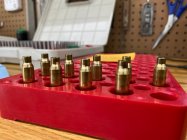
.0002 deeper (cases should be in in same order between pics)
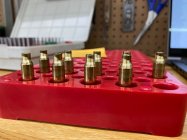
.0002 deeper
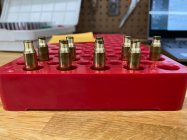
.0002 deeper again
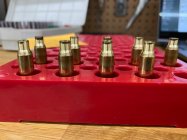
and last cut .0002 that ended up yielding .0120 target necks
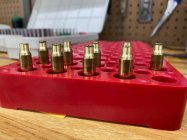
Hope this helps someone see the difference in necks as you cut them and why (in this case) I chose to do it.
Again - in other cases (Bart's) there is a more efficient way to get the results we're both trying to achieve in different contexts.
Last edited:
Happy to help Ned. This was the most frustrating caliber I’ve tried to make shoot thus far where as the 6BRA was certainly the easiest. Given the popularity, it surprised me it took so much work - enough that if I had to do it again I might have just decided to shoot a straight 6BR for practice instead !
Thanks for this - it's very timely for me. I've got severe donuts in my Lapua 223 brass. When I run a 0.223 mandrel down the neck by hand I can feel the wall. If I run it on my press it doesn't seem to take much force, but looking in the neck with a Teslong I can see the shiny band of the donut.
I just bought a 21st Century neck turning kit and have been cautiously trying it out. Am I correct in thinking that if I clean up my outside neck with this, going deep enough to where I barely kiss the shoulder, that when I then fire the case the inside donut will be pushed out and my problem will be cured? Am I missing anything?
I just bought a 21st Century neck turning kit and have been cautiously trying it out. Am I correct in thinking that if I clean up my outside neck with this, going deep enough to where I barely kiss the shoulder, that when I then fire the case the inside donut will be pushed out and my problem will be cured? Am I missing anything?
rwj
Gold $$ Contributor
Providing the 21st Century expander mandrel is used before turning, the donut will be reduced. It is unlikely that it will be completely eliminated.I just bought a 21st Century neck turning kit and have been cautiously trying it out. Am I correct in thinking that if I clean up my outside neck with this, going deep enough to where I barely kiss the shoulder, that when I then fire the case the inside donut will be pushed out and my problem will be cured? Am I missing anything?
When seated, does the bullet contact the area where the donut is located? If no, I wouldn’t be too concerned about whether the donut is present.
Providing the 21st Century expander mandrel is used before turning, the donut will be reduced. It is unlikely that it will be completely eliminated.
When seated, does the bullet contact the area where the donut is located? If no, I wouldn’t be too concerned about whether the donut is present.
Unfortunately the bullet does contact the donut.
Just to add a little to the discussion. My No Turn 6BRA won the Tac Driver.
So this demonstrates that great shooters can win with turned or unturned necks. Congratulations to both of you. I consider both of you to be good friends.My .268 turned Dashers won the 1k and 600 nats this year. LOL
I think that it's more about the tuning than the turning. I'm running .003" clearance but by turning I know it IS .003" everywhere. With a no turn I would think that as long you had sufficient clearance at the tightest spot than you should be good to go but that means you are going to have more than desired on the skinny sides. I'm curious to see what guys are running on clearance on the no turns. I'm going to run some Alpha Dasher brass in a .272 neck BUT I'm going to turn them and should end up with a shade over .003 clearance all said and done. I anneal all of my brass after every firing as well.
I for one am unable to let something go when I can measure it and see it can be improved upon. I have plenty of time to turn necks, weigh primers, sort bullets etc. during the winter months. Much of this game, after learning the basics, and going through the learning curve, is played between the ears and confidence is the biggest part of that. For me to go to the line with ammunition that I know can be made more consistent would erode that confidence so I say why not turn necks?
Until someone proves to me that turning necks makes my ammunition LESS accurate I for one will continue to do so.
I can’t wait to shoot with both of you in 2022!
Dave.
Dave,So this demonstrates that great shooters can win with turned or unturned necks. Congratulations to both of you. I consider both of you to be good friends.
I for one am unable to let something go when I can measure it and see it can be improved upon. I have plenty of time to turn necks, weigh primers, sort bullets etc. during the winter months. Much of this game, after learning the basics, and going through the learning curve, is played between the ears and confidence is the biggest part of that. For me to go to the line with ammunition that I know can be made more consistent would erode that confidence so I say why not turn necks?
Until someone proves to me that turning necks makes my ammunition LESS accurate I for one will continue to do so.
I can’t wait to shoot with both of you in 2022!
Dave.
Only you can prove it to yourself. No way you’ll be convinced otherwise. I never would have believed it.
Here’s some food for thought. Just because you’re turning necks doesn’t mean they are better. I’ve worked with a lot of shooters trying to figure out why their guns quit shooting. Many times it’s because of issues they had while turning necks. Such as; too thick, too thin, cutters moving, cutters not working properly, cutters not maintain the same cut all the way down the neck, cuts too deep into the shoulder and the hits go on and on. So there many problems that can be introduced by turning necks.
With my setup I’ve proven it to myself. It probably won’t work with all brass and all calibers, but it works with mine (6BRA AND 6PPC). I’m not trying to get anyone to come over to the darkside, everybody needs to do what they feel works for them. If your gun is competitive it’s competitive turned brass or unturned.
Bart
Last edited:
Dave,
Only you can prove it to yourself. No way you’ll be convinced otherwise. I never would have believed it.
Here’s some food for thought. Just because you’re turning necks doesn’t mean they are better. I’ve worked with a lot of shooters trying to figure out why their guns quit shooting. Many times it’s because of issues they had while turning necks. Such as; too thick, too thin, cutters moving, cutters not working properly, cutters not maintain the same cut all the way down the neck, cuts too deep into the shoulder and the hits go on and on. So there many problems that can be introduced by turning necks.
With my setup I’ve proven it to myself. It probably won’t work with all brass and all calibers, but it works with mine (6BRA AND 6PPC). I’m not trying to get anyone to come over to the darkside, everybody needs to do what they feel works for them. If your gun is competitive it’s competitive turned brass or unturned.
Bart
They’re competitive… if you are velocity sorting all your cases. I’d argue that you are simply jumping to the direct measurement for the limited set of cases you need, whereas others are trying to achieve this through neck turning and weight (or volume) sorting of cases.
Do you think your gun would shoot as well with cases straight out of the box and no measurement/prep work?
Last edited:
No I don’t. Especially for 600/1000 yard Benchrest. You have to find the outliers otherwise you’ll get a surprise and not the good kind.They’re competitive… if you are velocity sorting all your cases. I’d argue that you are simply jumping to the direct measurement for the limited set of cases you need, whereas others are trying to achieve this through neck turning and weight (or volume) sorting of cases.
Do you think your gun would shoot as well with cases straight out of the box and no measurement/prep work?
Bart
JEFFPPC
Gold $$ Contributor
Are you sorting for outliers by SD or ES?No I don’t. Especially for 600/1000 yard Benchrest. You have to find the outliers otherwise you’ll get a surprise and not the good kind.
Bart
ES I pay no attention to SD.Are you sorting for outliers by SD or ES?
Similar threads
- Replies
- 7
- Views
- 1,638
Upgrades & Donations
This Forum's expenses are primarily paid by member contributions. You can upgrade your Forum membership in seconds. Gold and Silver members get unlimited FREE classifieds for one year. Gold members can upload custom avatars.

Click Upgrade Membership Button ABOVE to get Gold or Silver Status.
You can also donate any amount, large or small, with the button below. Include your Forum Name in the PayPal Notes field.
To DONATE by CHECK, or make a recurring donation, CLICK HERE to learn how.

Click Upgrade Membership Button ABOVE to get Gold or Silver Status.
You can also donate any amount, large or small, with the button below. Include your Forum Name in the PayPal Notes field.
To DONATE by CHECK, or make a recurring donation, CLICK HERE to learn how.









